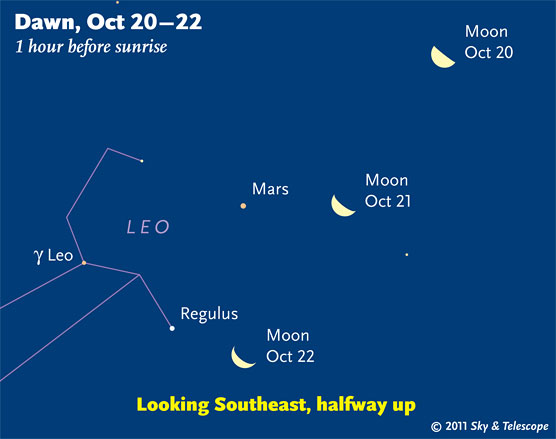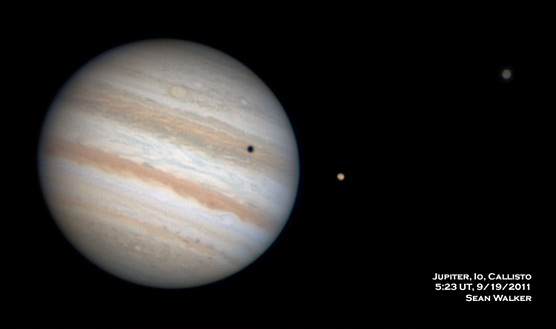
The waning Moon passes Mars and Regulus at dawn.
Sky & Telescope diagram
Friday, Oct. 14
Saturday, Oct. 15
Sunday, Oct. 16
Monday, Oct. 17
Tuesday, Oct. 18
Wednesday, Oct. 19
( For timetables of all of Jupiter's Red Spot transits and satellite events this month, good worldwide, see the October Sky & Telescope, page 54.)
Thursday, Oct. 20
Friday, Oct. 21
Saturday, Oct. 22
Want to become a better amateur astronomer? Learn your way around the constellations. They're the key to locating everything fainter and deeper to hunt with binoculars or a telescope.
For an easy-to-use constellation guide covering the whole evening sky, use the big monthly map in the center of each issue of Sky & Telescope, the essential magazine of astronomy. Or download our free Getting Started in Astronomy booklet (which only has bimonthly maps).

The Pocket Sky Atlas plots 30,796 stars to magnitude 7.6 — which may sound like a lot, but that's less than one star in an entire telescopic field of view, on average. By comparison, Sky Atlas 2000.0 plots 81,312 stars to magnitude 8.5, typically one or two stars per telescopic field. Both atlases include many hundreds of deep-sky targets — galaxies, star clusters, and nebulae — to hunt among the stars.
Sky & Telescope
Once you get a telescope, to put it to good use you must have a detailed, large-scale sky atlas (set of charts). The standards are the Pocket Sky Atlas, which shows stars to magnitude 7.6; the larger and deeper Sky Atlas 2000.0 (stars to magnitude 8.5); and the even larger Uranometria 2000.0 (stars to magnitude 9.75). And read how to use sky charts effectively.
You'll also want a good deep-sky guidebook, such as Sue French's new Deep-Sky Wonders collection (which includes its own charts), Sky Atlas 2000.0 Companion by Strong and Sinnott, the bigger Night Sky Observer's Guide by Kepple and Sanner, or the classic if dated Burnham's Celestial Handbook.
Can a computerized telescope take their place? I don't think so — not for beginners, anyway, and especially not on mounts that are less than top-quality mechanically. As Terence Dickinson and Alan Dyer say in their Backyard Astronomer's Guide, "A full appreciation of the universe cannot come without developing the skills to find things in the sky and understanding how the sky works. This knowledge comes only by spending time under the stars with star maps in hand."
This Week's Planet Roundup
Mercury (about magnitude –0.5) is very deep in the sunset. For a real challenge, if the air is very clear, use binoculars or a telescope shortly after sundown this week to see if you can pick up Mercury 3° to 5° lower right of Venus.
Venus (magnitude –3.9) is just above the west-southwest horizon 15 or 20 minutes after sunset. Binoculars help. If you spot Venus, you'll be one of a small number to see it this early in its apparition — compared to the billions of people who will see it as the Evening Star blazing high in twilight in the coming months.
Mars (magnitude +1.2, crossing from Cancer into Leo) rises around 1 or 2 a.m. daylight-saving time. By the beginning of dawn it's in good view high in the east. Below it by roughly 12° is Regulus, similar in brightness. In a telescope Mars is a tiny blob only 5.5 arcseconds wide.

Io and darker Callisto were just east of Jupiter when S&T's Sean Walker imaged the scene on the morning of September 19th. South is up. Note the reddish Oval BA, "Red Spot Junior," just past the central meridian in the South Temperate Belt.
S&T: Sean Walker
Jupiter (magnitude –2.9, in southern Aries) shines low in the east-northeast in twilight and blazes brightly higher in the east to southeast all evening. Look above it for the stars of Aries and below it for the head of Cetus, rather dim. (And keep checking in on Mira, now coming off an unusually bright maximum and still naked-eye, to the right of the head of Cetus; see article.)
Jupiter is nearly at its highest by midnight now. It's a big 49 arcseconds wide, essentially as big as it will appear at its October 28th opposition. See our guide to observing Jupiter with a telescope.
Saturn is out of sight in conjunction behind the Sun.
Uranus (magnitude 5.7, in Pisces) and Neptune (magnitude 7.9, in Aquarius) are well placed in the south and southeast by mid-evening. Use our printable finder chart for both, or see the September Sky & Telescope, page 53.
All descriptions that relate to your horizon — including the words up, down, right, and left — are written for the world's mid-northern latitudes. Descriptions that also depend on longitude (mainly Moon positions) are for North America. Eastern Daylight Time (EDT) equals Universal Time (also known as UT, UTC, or GMT) minus 4 hours.
NEW BOOK: Sue French's DEEP-SKY WONDERS! This big, long-awaited observing guide by Sky & Telescope's Sue French is now available from Shop at Sky. Hefty and lavishly illustrated, it contains Sue’s 100 favorite sky tours (25 per season, with finder charts) from her 11 years of writing the Celestial Sampler and Deep-Sky Wonders columns for S&T. Don’t miss it!
To be sure to get the current Sky at a Glance, bookmark this URL:
http://SkyandTelescope.com/observing/ataglance?1=1
If pictures fail to load, refresh the page. If they still fail to load, change the 1 at the end of the URL to any other character and try again.
 0
0
Comments
You must be logged in to post a comment.